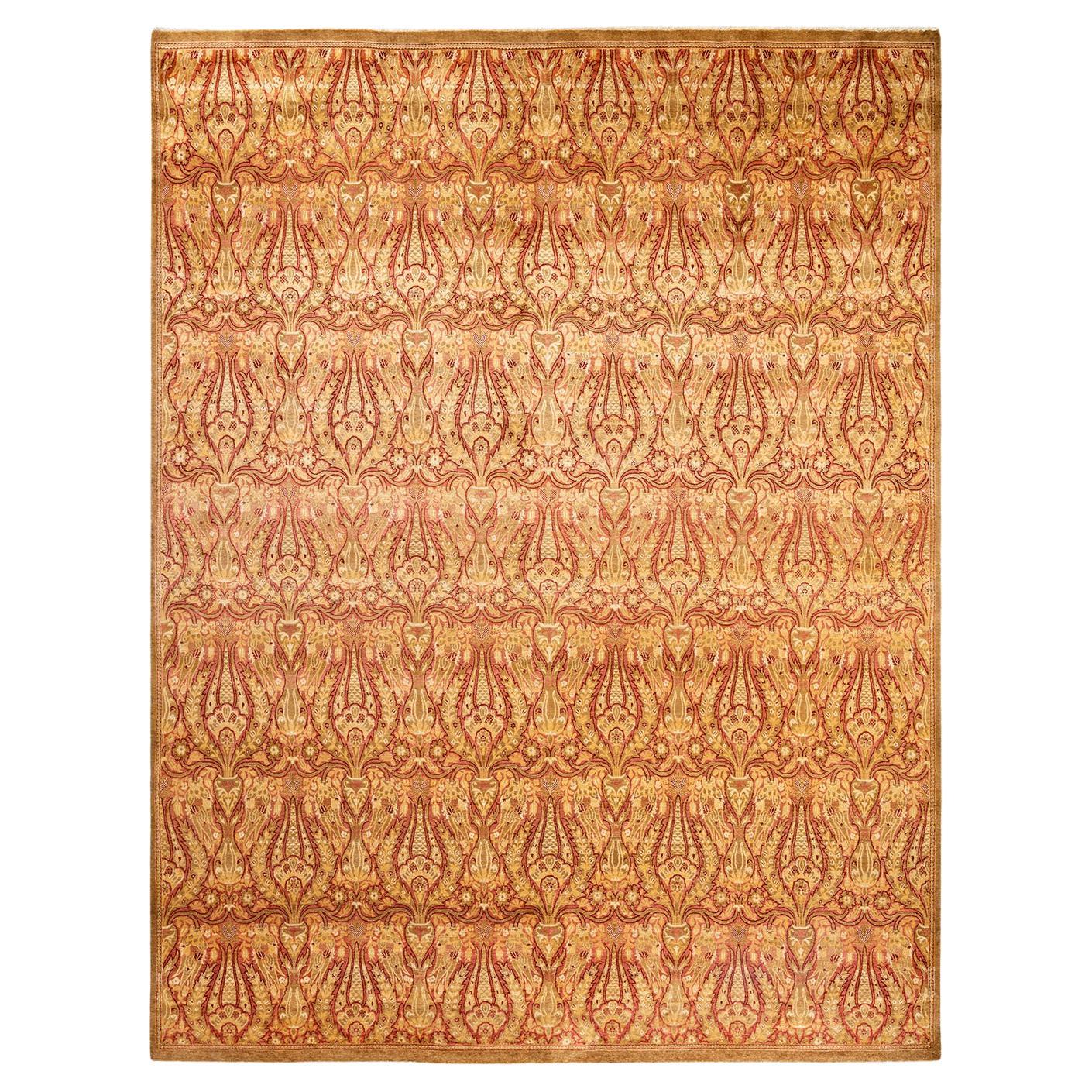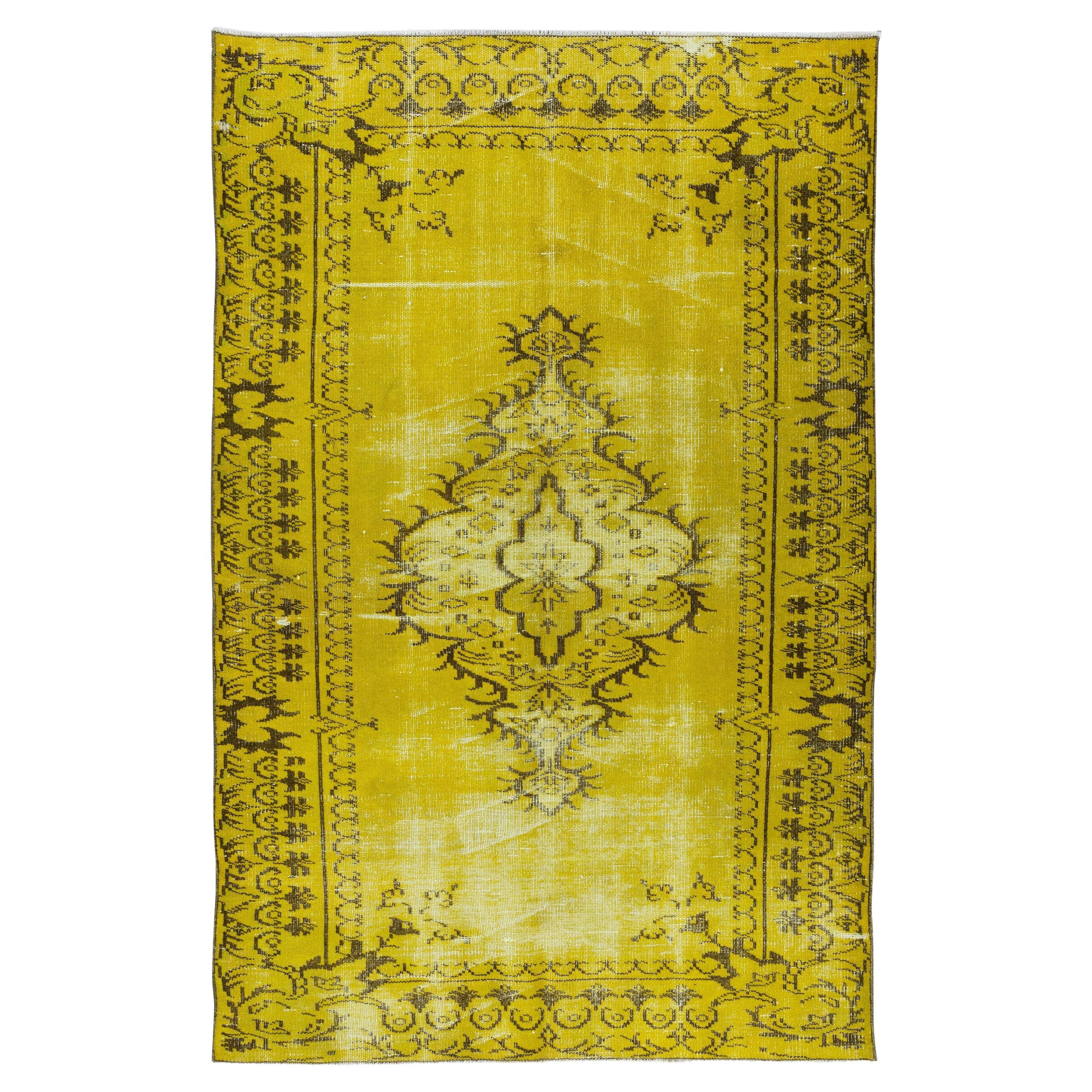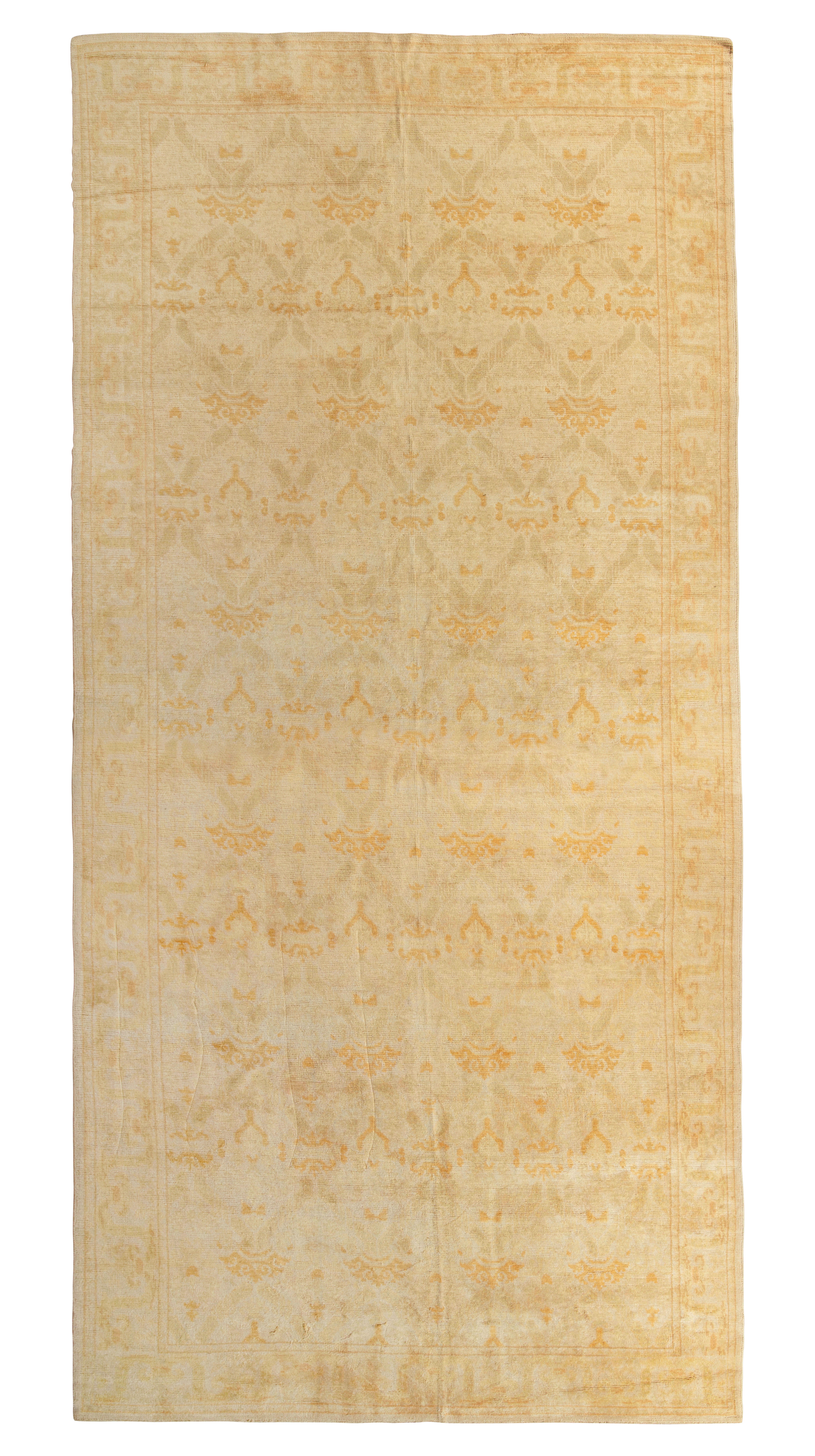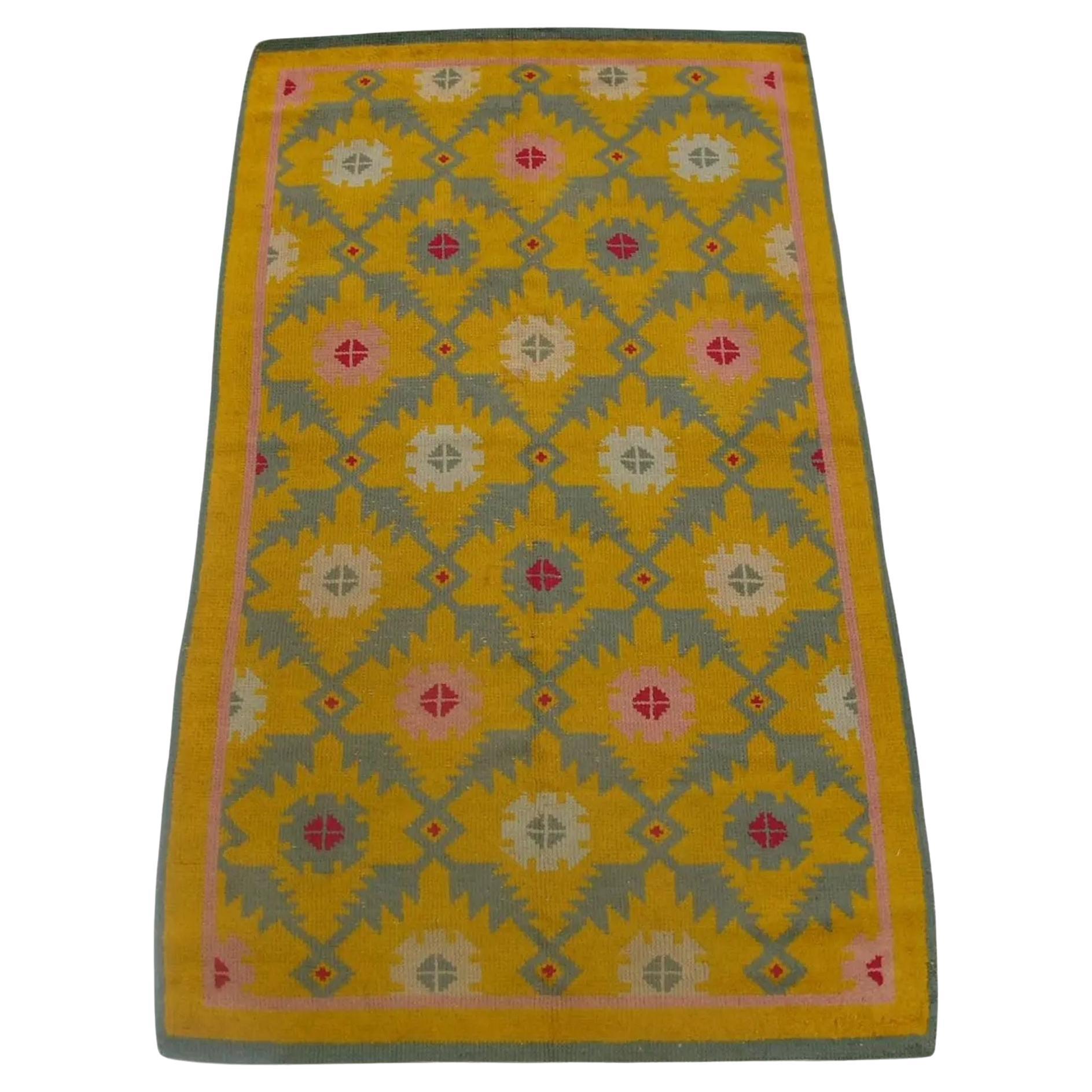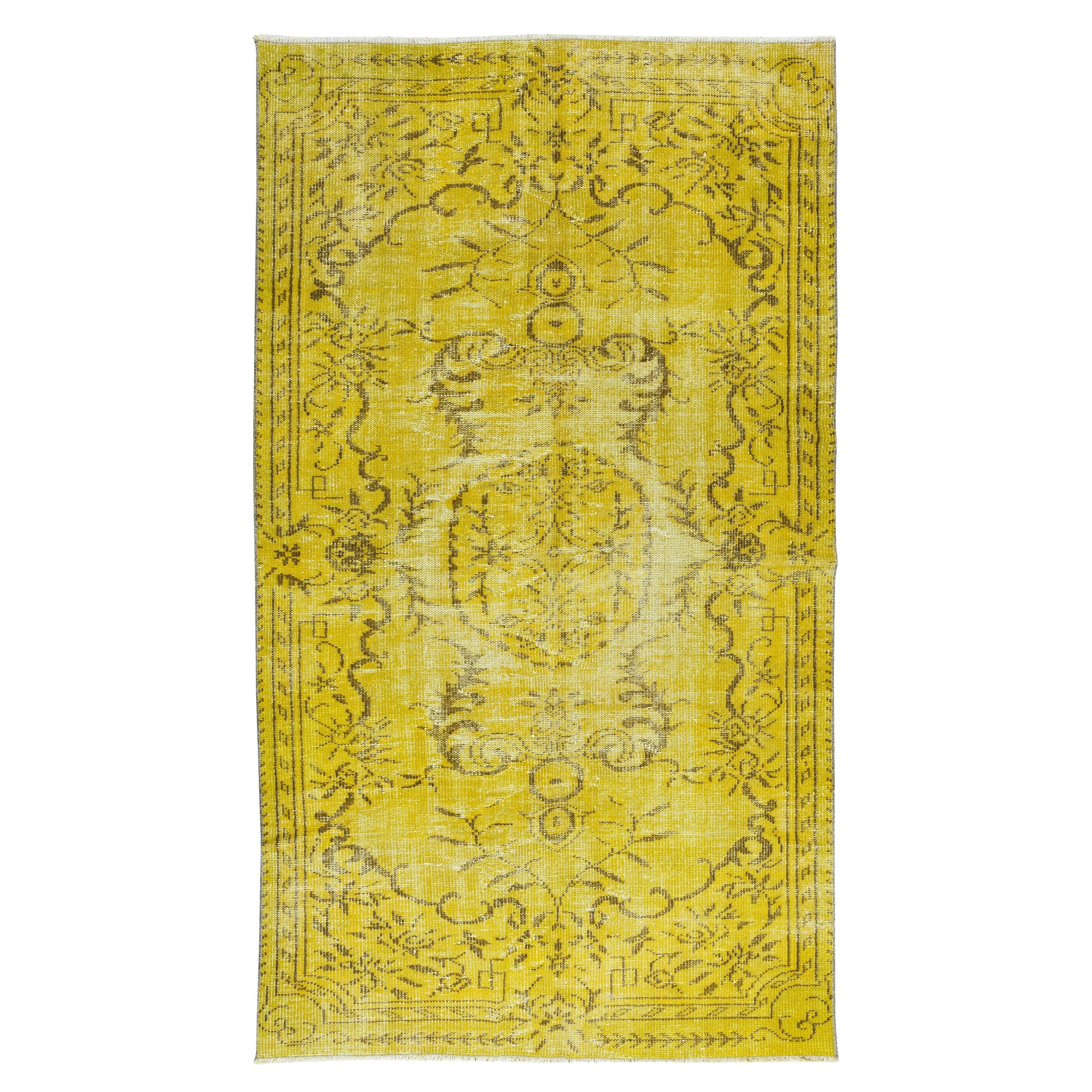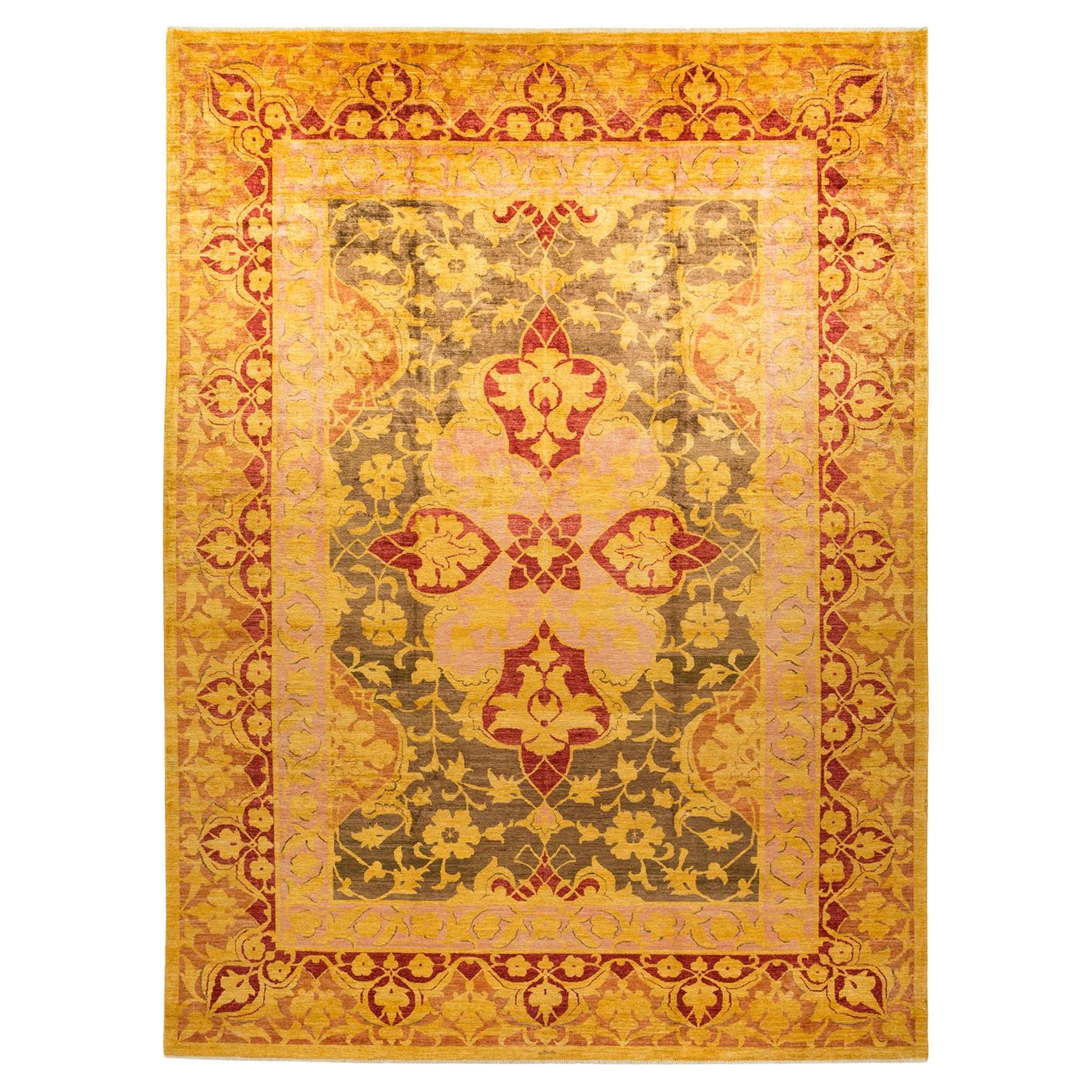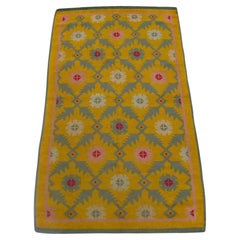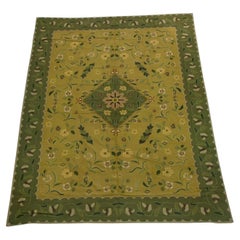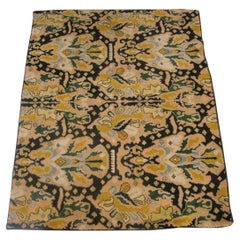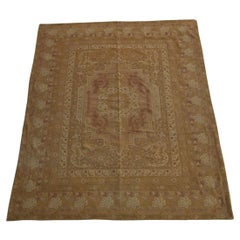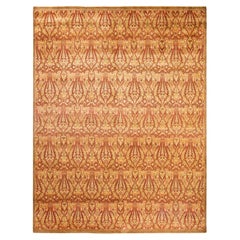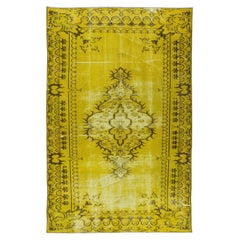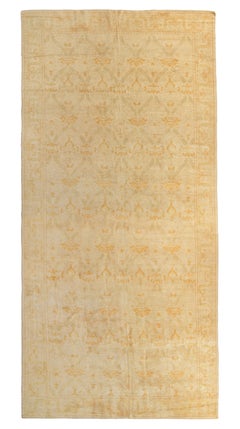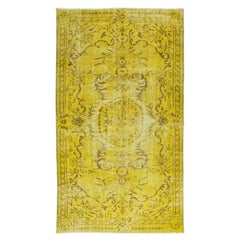Items Similar to 1900 Antique Yellow Abstract Style European Needlework Rug
Want more images or videos?
Request additional images or videos from the seller
1 of 5
1900 Antique Yellow Abstract Style European Needlework Rug
$4,800
£3,628.21
€4,169.45
CA$6,683.97
A$7,435.64
CHF 3,897.86
MX$90,861.75
NOK 49,634.35
SEK 46,723.87
DKK 31,123.38
Shipping
Retrieving quote...The 1stDibs Promise:
Authenticity Guarantee,
Money-Back Guarantee,
24-Hour Cancellation
About the Item
Archaeologists and scholars consider the roots of needlepoint to have been around 1500 BC. They consider the first needlepoint to include the fine diagonal stitches that were used to sew tents together by the ancient Egyptians. The art eventually evolved into tapestry weaving. However, a tapestry weaving differs significantly from needlepoint in that it uses a loom and vertical warp.
Tapestry weaving is closer to the weaving of kilims and pile rugs than canvas work. However, some still include tapestry weaving in the category of needlepoint because of the fine work that appeared during the late Renaissance. It can have a similar appearance to the untrained eye. Technically, tapestry weaving and needlepoint are not the same, and they do not use the same technique.
About the Seller
5.0
Platinum Seller
Premium sellers with a 4.7+ rating and 24-hour response times
Established in 1920
1stDibs seller since 2023
63 sales on 1stDibs
Typical response time: <1 hour
- ShippingRetrieving quote...Shipping from: Los Angeles, US
- Return Policy
Authenticity Guarantee
In the unlikely event there’s an issue with an item’s authenticity, contact us within 1 year for a full refund. DetailsMoney-Back Guarantee
If your item is not as described, is damaged in transit, or does not arrive, contact us within 7 days for a full refund. Details24-Hour Cancellation
You have a 24-hour grace period in which to reconsider your purchase, with no questions asked.Vetted Professional Sellers
Our world-class sellers must adhere to strict standards for service and quality, maintaining the integrity of our listings.Price-Match Guarantee
If you find that a seller listed the same item for a lower price elsewhere, we’ll match it.Trusted Global Delivery
Our best-in-class carrier network provides specialized shipping options worldwide, including custom delivery.More From This Seller
View All1900 Antique Spanish Yellow Rug 6'11'' X 3'10''
Located in Los Angeles, US
Spanish Rugs – Although Spain is not generally thought of as a rug producing region, Spanish rugs represent the most venerable and honored tradition of rug production in Europe, goin...
Category
Antique Early 1900s Spanish Spanish Colonial Western European Rugs
Materials
Paste
1920 Floral Yellow Needlepoint Rug
Located in Los Angeles, US
Needlepoint rugs were created using the traditional needlework weaving technique that is used to make everyday items from furniture to carpets and artwork. However, it has a fascinat...
Category
Vintage 1920s Unknown Empire Western European Rugs
Materials
Wool, Cotton
Late-19th Century Spanish Woolen Rug
Located in Los Angeles, US
Late-19th Century Spanish Woolen Rug 6'3'' x 4'10", made in Spain around late 19th century by villagers at the time
Category
Vintage 1920s Empire Russian and Scandinavian Rugs
Materials
Wool
1900s Antique French Needlepoint Rug
Located in Los Angeles, US
Needlepoint rugs were created using the traditional needlework weaving technique that is used to make everyday items from furniture to carpets and artwork. However, it has a fascinating history both as a hobby and as an industry. When many people think of carpets, they think of pile carpets or flat weave kilims, but needlepoint has also been used to create beautiful carpets. These carpets are durable and an important part of carpet history.
Archaeologists and scholars consider the roots of needlepoint to have been around 1500 BC. They consider the first needlepoint to include the fine diagonal stitches that were used to sew tents together by the ancient Egyptians. The art eventually evolved into tapestry weaving. However, a tapestry weaving differs significantly from needlepoint in that it uses a loom and vertical warp.
Tapestry weaving is closer to the weaving of kilims and pile rugs than canvas work. However, some still include tapestry weaving in the category of needlepoint because of the fine work that appeared during the late Renaissance. It can have a similar appearance to the untrained eye. Technically, tapestry weaving and needlepoint are not the same, and they do not use the same technique.
The first actual needlepoint rugs and needle-points began to appear in the late Renaissance. Needlepoint is worked by creating stitches on a stiff canvas. The canvas is typically made from jute or linen and is quite durable. Pieces from the Renaissance were used to cover footstools, chairs, pillows, bed headboards, and other furnishings. They were also used as table coverings and wall coverings. You could also find them on many small items such as purses, shoes, and various adornments for clothing.
During the Renaissance, the craft reached a high level of skill, and the designs became incredibly detailed and realistic. They mimicked many of the subjects and styles of famous paintings of the time. They created florals, still life designs, scenes, and geometric tiled pieces. Some of them mimicked the designs found in Persian Carpets.
Needlepoint reached its peak popularity in the 19th century when it was considered a proper occupation for a lady. Needlepoint and embroidery held a similar place in societal status at the time. During this time, the work became finer, with some of the canvas reaching a high level of detail. The level of detail is determined by counting the number of mesh in an inch. During this time petit point by French needlewomen could have a mesh count as high as 45 mesh. This allowed women to create highly intricate designs with incredible levels of detail.
It is possible to find many antique pieces of needlepoint besides rugs. Needlepoint rugs were popular in France and Spain, where the technique was adapted to create highly intricate designs that mimicked the designs in architecture and fashion. They were popular because they were durable, and it could be fashioned into a variety of items. The canvases themselves were durable, and the wool that they used was also strong, which means that many of the pieces were able to withstand daily use. We have many artifacts that have survived from this time period.
Needlepoint rugs are important collectibles because they are different from the pile rugs and kilims that are typically found on the market. Needlepoint carpets are special because they take many hours to create, especially larger works. Needlepoint pieces of any type became popular throughout Europe during the 19th century. It is still a popular hobby today, but perhaps one of the most interesting stories is that of the Portuguese needlewomen of Arraiolos.
The story of these women and their beautiful carpets begins in 1492. Needlepoint was a popular occupation in Spain, which had a large population of Moors and Jews. They were an integral part of Spanish culture. However, in 1492, Queen Isabella of Spain issued a proclamation that gave these ethnic groups the order to pack their bags and board ships headed...
Category
Antique Early 1900s Other Russian and Scandinavian Rugs
Materials
Wool, Cotton
Antique Portuguese Rug 8.4x4.0
Located in Los Angeles, US
Antique PORTUGUESE Rug 8.4X4.0, handmade , traditional European style
Category
Vintage 1910s Other Russian and Scandinavian Rugs
Materials
Wool, Cotton
Early 20th Century Antique British Needlework Rug
Located in Los Angeles, US
Needlepoint rugs were created using the traditional needlework weaving technique that is used to make everyday items from furniture to carpets and artwork. However, it has a fascinat...
Category
Early 20th Century Other Russian and Scandinavian Rugs
Materials
Wool, Cotton
You May Also Like
One-of-a-Kind Hand Made Traditional Mogul Yellow Area Rug
Located in Norwalk, CT
With understated palettes and allover designs, the rugs in the Mogul Collection will bring timeless sophistication to any room. Influenced by a spectrum of Turkish, Indian, and Persi...
Category
Early 2000s Pakistani Other Central Asian Rugs
Materials
Wool
$1,821 Sale Price
20% Off
5.2x8.3 Ft Vintage Handmade Turkish Rug Overdyed in Yellow with Medallion Design
Located in Spring Valley, NY
Our over-dyed rugs are all hand-knotted vintage pieces that are recreated in our workshop to cater to a wider range of interior design choices from modern to coastal, from industrial...
Category
20th Century Turkish Modern Turkish Rugs
Materials
Wool, Cotton
$549 Sale Price
35% Off
Hand-Knotted Antique European Rug, Gold, Yellow, Floral Pattern by Rug & Kilim
Located in Long Island City, NY
Originating in Spain circa 1920-1930, this 12 x 24 rug makes a fabulous entry to the European selections in Rug & Kilim’s Antique & Vintage Collection. Hand kno...
Category
Vintage 1920s Spanish Other Western European Rugs
Materials
Wool
4.8x8.5 Ft Handmade Vintage Turkish Area Rug, Modern Yellow Carpet
Located in Spring Valley, NY
Our over-dyed rugs are all hand-knotted vintage pieces that are recreated in our workshop to cater to a wider range of interior design choices from modern to coastal, from industrial...
Category
20th Century Turkish Modern Turkish Rugs
Materials
Wool, Cotton
$565 Sale Price
30% Off
One-Of-A-Kind Hand Made Contemporary Eclectic Yellow Area Rug
Located in Norwalk, CT
With an amalgam of sizes and aesthetic influences ranging from art deco to Rorschach and modernist, the rugs in the Eclectic collection defy definition, asking instead to become intr...
Category
Early 2000s Pakistani Other Central Asian Rugs
Materials
Wool
$2,883 Sale Price
20% Off
One-of-a-kind Hand Knotted Wool Mogul Yellow Area Rug
Located in Norwalk, CT
With understated palettes and allover designs, the rugs in the Mogul Collection will bring timeless sophistication to any room. Influenced by a spectrum of Turkish, Indian, and Persi...
Category
21st Century and Contemporary Pakistani Central Asian Rugs
Materials
Wool
$958 Sale Price
20% Off
More Ways To Browse
Egyptian Tapestry
Vertical Tapestry
Tapestry Looms Used
Needlepoint Canvas
Egyptian Tent
Eye Dining Chairs
Inlay Dining Table Vintage
Made In Mexico Coffee Table
Painted Chinoiserie Table
Black Pedestal Marble
California Ceramics
Chippendale Chair Queen Anne
Enamel Butterfly
Entrance Hall Table
European High Back Chairs
France Rattan Table
Free Edge Tables
Luna Modern
